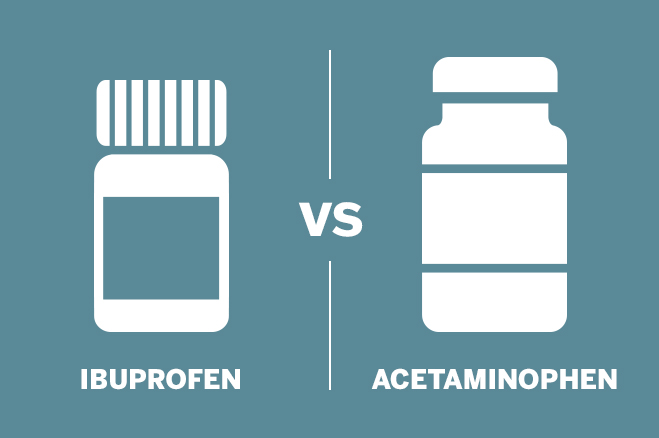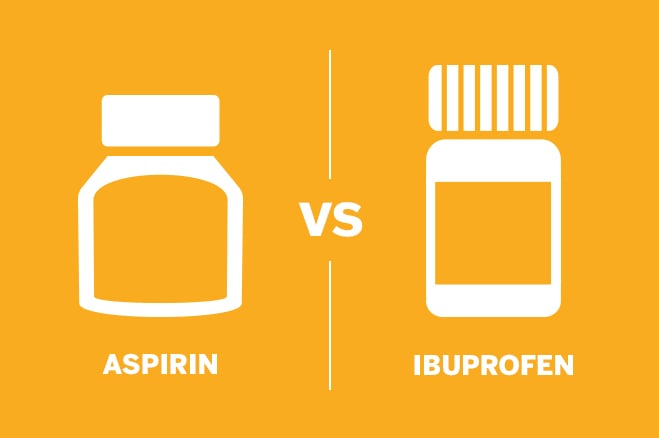This is not an exhaustive list of OTC pain reliever comparisons. These comparisons are also not recommendations. If you have any questions about choosing or using OTC pain relievers, talk with your healthcare professional.
Ibuprofen vs Acetaminophen
Ibuprofen: Motrin® IB, Advil®
Acetaminophen: Tylenol®
Ibuprofen: Yes
Acetaminophen: No
Ibuprofen and acetaminophen both temporarily reduce fever and relieve minor aches and pains due to:
headache
muscular aches
minor pain of arthritis
toothache
backache
the common cold
menstrual cramps
Acetaminophen is also used to temporarily relieve pain due to premenstrual cramps.
Remember! Even if you're in a lot of pain, it's not safe to take more medicine than the label says. And not all pain relievers are appropriate for everyone. Consider your health conditions.
Ibuprofen and acetaminophen contain different active ingredients. There may be times when these OTC pain relievers can be taken together, but you should always talk to your healthcare professional before taking more than one type of medicine in 24 hours.
Ibuprofen: If you take more than directed or for longer than directed, the risk of stomach bleeding increases.
Ibuprofen increases the risk of heart attack, heart failure, and stroke. The risk is higher if you use more than directed or for longer than directed.
If you are pregnant, please read and follow the label for specific warnings.
Acetaminophen: If you take too much (more than 4,000 mg in 24 hours), you could harm your liver.
This is not a full list of warnings. Check the Drug Facts label on your medicine’s carton for a full list of warnings. Download and save a guide to Drug Facts labels.
It is not safe to apply the dosing directions from one pain reliever to another. Download and save this OTC pain reliever dosage chart to ensure you take these pain relievers safely.
Ibuprofen: For your safety, do not take more than 1,200 mg in 24 hours.
Acetaminophen: For your safety, do not take more than 4,000 mg in 24 hours.
Aspirin vs Ibuprofen
Aspirin: Bayer® Extra Strength
Ibuprofen: Motrin® IB, Advil®
Aspirin and ibuprofen are both used to temporarily relieve minor aches and pains due to:
headache
muscle pain
minor pain of arthritis
toothache
the common cold*
menstrual cramps
backache
temporarily reduce fever
Remember! Even if you're in a lot of pain, it's not safe to take more medicine than the label says. And not all pain relievers are appropriate for everyone. Consider your health conditions.
No. Taking more than one NSAID at a time increases your risk of stomach bleeding.
Additionally, if you take aspirin to help protect against heart attack or stroke, ibuprofen can decrease aspirin’s heart health benefits.
Take ONLY 1 medicine that contains an NSAID at a time.
Aspirin and Ibuprofen: If you take more than directed or for longer than directed, the risk of stomach bleeding increases.
Ibuprofen increases the risk of heart attack, heart failure, and stroke. The risk is higher if you use more than directed or for longer than directed.
If you are pregnant, please read and follow the label for specific warnings.
This is not a full list of warnings. Check the Drug Facts label on your medicine’s carton for a full list of warnings. Download and save a guide to Drug Facts labels.
It is not safe to apply the dosing directions from one NSAID to another. Download and save this OTC pain reliever dosage chart to ensure you take these pain relievers safely.
Aspirin: For your safety, do not take more than 4,000 mg in 24 hours.
Ibuprofen: For your safety, do not take more than 1,200 mg in 24 hours.
Naproxen sodium vs Ibuprofen
Naproxen sodium: Aleve®
Ibuprofen: Motrin® IB, Advil®
Naproxen sodium: Yes
Ibuprofen: Yes
Naproxen sodium and ibuprofen both temporarily reduce fever and relieve minor aches and pains due to:
headache
muscular aches
minor pain of arthritis
toothache
backache
the common cold
menstrual cramps
Remember! Even if you're in a lot of pain, it's not safe to take more medicine than the label says. And not all pain relievers are appropriate for everyone. Consider your health conditions.
Taking more than one NSAID at a time increases your risk of stomach bleeding.
Take ONLY 1 medicine that contains an NSAID at a time.
Naproxen sodium and Ibuprofen: If you take more than directed or for longer than directed, the risk of stomach bleeding increases.
Ibuprofen and naproxen sodium increase the risk of heart attack, heart failure, and stroke. The risk is higher if you use more than directed or for longer than directed.
If you are pregnant, please read and follow the label for specific warnings.
This is not a full list of warnings. Check the Drug Facts label on your medicine’s carton for a full list of warnings. Download and save a guide to Drug Facts labels.
It is not safe to apply the dosing directions from one NSAID to another. Download and save this OTC pain reliever dosage chart to ensure you take these pain relievers safely.
Naproxen sodium: For your safety, do not take more than 660 mg in 24 hours.
Ibuprofen: For your safety, do not take more than 1,200 mg in 24 hours.



